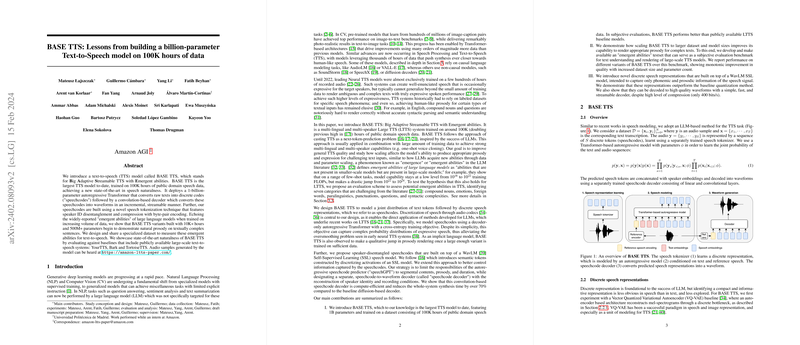Building a Billion-Parameter Text-to-Speech Model: Insights from BASE TTS
Introduction to BASE TTS
BASE TTS introduces a novel direction in Text-to-Speech (TTS) technology, leveraging the potential of large-scale LLMs and novel speech tokenization techniques. The paper demonstrates a significant leap in speech synthesis by utilizing a billion-parameter model trained on an unprecedented dataset of 100,000 hours of speech. This model, named Big Adaptive Streamable TTS with Emergent abilities (BASE TTS), encapsulates the essence of bringing text-to-speech synthesis closer to a natural human-like performance, particularly in rendering textually complex sentences with natural prosody.
Novel Contributions
The main contributions of this work are threefold:
- Largest TTS Model: BASE TTS sets a new benchmark in the field by being the largest model to date, with 1 billion parameters. It outperforms existing large-scale TTS models in subjective evaluations, providing more natural speech synthesis.
- Emergent Abilities and Benchmark: By scaling the model and dataset size, BASE TTS exhibits emergent abilities, allowing it to effectively render complex prosodic patterns and textual nuances. A specialized dataset and subjective evaluation benchmark for "emergent abilities" in TTS are also introduced, enabling systematic paper of model performance against challenging linguistic phenomena.
- Novel Speech Representations: The introduction of speaker-disentangled speechcodes, built atop a WavLM Self-Supervised Learning model, demonstrates a sophisticated method to capture only the essential phonemic and prosodic information, achieving high-quality waveform synthesis even at significant compression rates.
Technical Overview
BASE TTS approaches the challenge of TTS through an LLM-based paradigm, treating TTS as a next-token-prediction problem. The model architecture comprises a Transformer-based autoregressive model coupled with discrete speech representations termed speechcodes. These speechcodes, derived using a novel tokenization technique, encapsulate speaker ID disentanglement and compression. For the practical application of converting these speechcodes into waveforms, a convolution-based speechcode decoder is employed, markedly enhancing computational efficiency without sacrificing speech quality.
The dataset used for training BASE TTS, consisting of 100,000 hours of public domain speech data, is significantly more extensive than those used in prior studies, aiding the model in learning from a diverse set of linguistic and prosodic patterns. Notably, BASE TTS employs strategies such as Byte-Pair Encoding (BPE) on speechcodes to optimize sequence length and thus model performance over longer audio sequences.
Theoretical Implications and Future Prospects
The implication of this research extends beyond mere improvement in TTS quality; it explores the potential emergence of new capabilities as TTS models scale. The phenomenon, observed in LLMs, where qualitative leaps in capability occur beyond certain scale thresholds, is hypothesized to apply to LTTS as well. BASE TTS's performance on the emergent abilities benchmark underscores the lasting impact of model and data scaling on TTS quality and complexity handling.
Future directions highlighted by this work include exploring the scalability of BASE TTS further and integrating text-only LLM knowledge to close the performance gaps in syntactic complexity and emotional expression. Additionally, addressing limitations such as occasional hallucinations or synthesis cutoffs emerging from autoregressive modeling is pivotal. Coupled with ethical considerations around misuse and biases within speech models, these form critical avenues for ongoing research.
Conclusion
BASE TTS's achievements herald a new era in TTS research, promising significantly more natural and expressive synthetic speech. By combining innovative speech tokenization methods with the power of large-scale datasets and models, BASE TTS paves the way for advancements in speech synthesis that could have wide-ranging applications, from enhancing communication aids to creating more immersive interactive systems.
